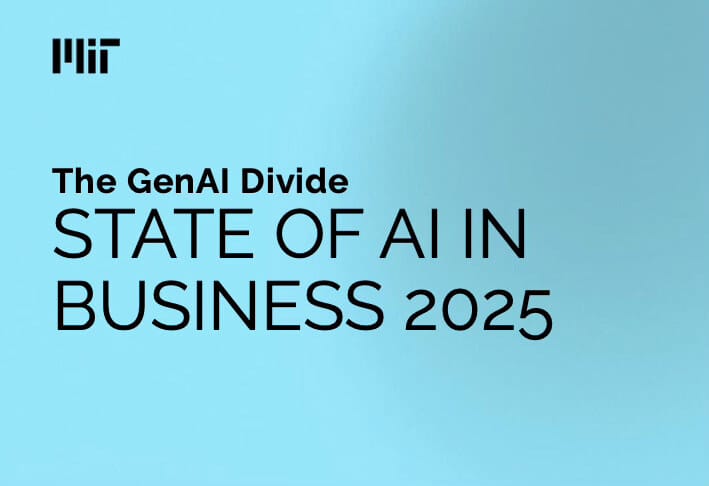- Pascal's Chatbot Q&As
- Posts
- The AI boom, while real, is being misallocated into the wrong priorities and mistaken for transformation when it is often merely automation of superficial tasks.
The AI boom, while real, is being misallocated into the wrong priorities and mistaken for transformation when it is often merely automation of superficial tasks.
The next 12–18 months are critical. Enterprises that cross the divide will gain lasting competitive advantages in data learning, workforce efficiency, and process intelligence.
Bridging the GenAI Divide: An Essay on Enterprise AI’s False Starts and Future Pathways
By ChatGPT-4o
1. Introduction: The Mirage of AI Maturity
The AI gold rush of the 2020s has seen tens of billions invested by enterprises chasing transformation. Yet, MIT’s latest State of AI in Business 2025 report reveals a staggering truth: 95% of enterprise GenAI pilots are failing to deliver measurable returns, despite sky-high expectations and saturation-level adoption of tools like ChatGPT and Copilot. While AI dominates headlines and market caps, it fails quietly in the trenches of enterprise operations.
This essay distills key findings, highlights the most surprising and controversial claims, and proposes evidence-based recommendations tailored for AI makers, enterprise users, investors, regulators, and other stakeholders.
2. Key Findings: The GenAI Divide Explained
The GenAI Divide describes the gulf between high adoption and low transformation. It is not a divide of access, awareness, or investment—but of approach, architecture, and adaptation.
2.1 Surprising & Valuable Statements
Only 5% of GenAI pilots reach production and generate measurable P&L impact.
Generic tools (e.g., ChatGPT) succeed in adoption but fail in integration, especially for mission-critical workflows.
Enterprise internal builds fail twice as often as externally sourced, learning-capable tools.
The most effective GenAI systems are not the smartest, but the ones that remember, adapt, and integrate.
The “shadow AI economy”—unauthorized use of consumer LLMs—often outperforms official enterprise deployments.
2.2 Controversial Observations
The problem isn't regulation, talent, or model quality—it’s the failure to learn and adapt within enterprise workflows.
AI vendor selection is driven by social proof and trust, not functionality, with referrals and existing vendor relationships outweighing innovation.
AI budgets are skewed toward sales and marketing, even though back-office functions yield the highest ROI—a misalignment caused by visibility bias.
Executives increasingly bypass central AI labs, preferring distributed experimentation and workflow-specific deployments.
3. Contextual Analysis: Why This Matters Now
This comes at a moment when:
Public markets are wobbling, with AI-linked stocks like Nvidia, Oracle, and Palantir suffering pullbacks amid growing skepticism about AI's near-term ROI.
Policymakers remain focused on model governance, while the true performance bottleneck lies in deployment design, workflow alignment, and adaptive learning capacity—areas underregulated and misunderstood.
Enterprises face vendor lock-in risks, with an 18-month window before early adopters cement long-term partnerships around agentic systems.
Together, these trends signal a potential AI bubble correction unless value delivery becomes provable, scalable, and measurable in real-world enterprise conditions.
4. Strategic Recommendations for Key Stakeholders
4.1 For AI Makers (Startups & Vendors)
Design for learning and persistence: Build agentic systems that retain context, learn from feedback, and adapt to workflows. Avoid one-size-fits-all solutions.
Start small, customize deeply: Focus on narrow but high-friction use cases (e.g., contract tagging, call summarization) before scaling up.
Leverage referral networks: Trust, not tech, drives adoption. Build credibility through system integrators, advisors, and existing vendor channels.
Implement memory frameworks (e.g., NANDA, MCP): These reduce context churn and enable distributed agents to coordinate across workflows.
4.2 For Enterprise Users (Buyers & Integrators)
Act like a BPO client, not a SaaS customer: Demand workflow integration, data boundaries, and performance-based accountability.
Enable bottom-up adoption: Shadow AI shows workers know what works—use their preferences as a blueprint for enterprise rollouts.
Invest in back-office transformation: Procurement, finance, and operations yield the highest ROI, yet remain underfunded due to visibility bias.
Don’t overbuild internally: Focus on co-development and external partnerships, which succeed 2x more often.
4.3 For Investors
Apply “value realism”: Don’t conflate model performance with business impact. Look for vendors solving for workflow learning, not just inference.
Watch for buyer-side stickiness: Startups embedding into enterprise systems with memory and feedback loops will accrue high switching costs.
Shift from GPU obsession to ROI metrics: Invest in vertical SaaS, agent orchestration, and domain-specific learning systems—not just hardware scale.
4.4 For Regulators & Policymakers
Refocus regulation on enterprise deployment risk: Today’s guardrails focus on model output. Future risks lie in how AI is operationalized within opaque systems.
Support open agent frameworks: Encourage interoperable memory systems (e.g., MCP, A2A) to prevent vendor lock-in and data monopolization.
Mandate transparency on enterprise ROI claims: Require public companies to disclose measurable impacts from AI deployments to avoid investor misinformation.
Incentivize back-office innovation: Provide tax credits or public grants for AI adoption in compliance, procurement, and administrative functions—not just front-end AI flash.
4.5 For Scholarly Publishers and Knowledge Guardians
Use the GenAI Divide to protect high-integrity knowledge workflows: Publishers can position themselves as trusted partners for agentic systems trained on reliable data.
Ensure contracts distinguish between inference and integration: Licensing must account for the persistent, memory-based reuse of scholarly works by agentic systems.
Support workforce tools that protect research fidelity: Help institutions experiment with tools that learn from structured workflows rather than replace them.
5. Conclusion: Moving Beyond the Hype Cycle
The GenAI Divide is not a failure of technology—it is a failure of fit, memory, and follow-through. The AI boom, while real, is being misallocated into the wrong priorities and mistaken for transformation when it is often merely automation of superficial tasks.
The next 12–18 months are critical. Enterprises that cross the divide will gain lasting competitive advantages in data learning, workforce efficiency, and process intelligence. Those who don’t will either overpay for brittle tools or stall in endless pilot purgatory.
Let’s shift the AI conversation from promise to practice—from hallucinations to habits. The divide is real. But it is crossable—if we build, buy, and regulate with eyes open.
🔍 Sources
